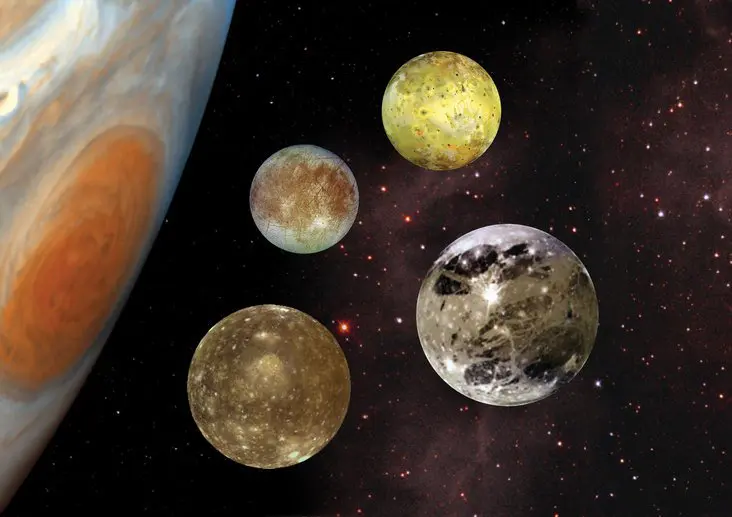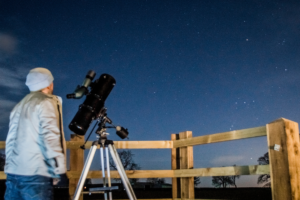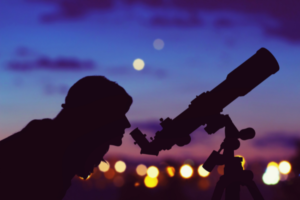Jupiter’s Moons – A Beginner’s Guide To Jovian Satellites
Jupiter presently has 79 known moons, out of which 53 have been named and the rest are awaiting their official names.
Most of the moons of Jupiter are small, with about 60 of them being less than 6.2 miles in diameter. The number of moons changes fairly frequently as the telescope technology improves, with the 79th moon being reported in 2018. No other planet in the solar system can match that figure. Saturn is the runner-up with its 62 verified moons while Uranus boasts 27 and Neptune has 14.
Key Takeaways:
- Jupiter has a large area of gravitational stability around it to support many moons.
- The four largest Jovian moons are Io, Europa, Ganymede and Callisto.
- All of the Jupiter’s moons probably formed in tandem with Jupiter itself.
- Many of the Jupiter’s moons orbit in the same direction in which Jupiter spins. But there are those which go the opposite way.
Most of the moons were discovered in the late 1970s and later as a result of several explorations by automated spacecraft, including NASA’s Voyager in 1979 and Galileo in 1995.
Four hundred years ago, the astronomer Galileo Galilei announced his discovery of four moons orbiting around the planet Jupiter, each seen as a distinct white dot through his telescope. However, only in the span of the last four decades have astronomers been able to study the Jovian moons in detail to reveal that the four—Io, Europa, Ganymede, and Callisto—are fascinating worlds of their own.

Illustration of Jupiter and the Galilean satellites. Credit: NASA
Why Does Jupiter Have 79 Moons When Earth Just Has One?
Jupiter is more than 300 times the mass of Earth. Its size plays a role in the number of moons orbiting Jupiter because there is a large area of gravitational stability around it to support many moons.
Jupiter also has the strongest magnetic field of any planet, so anything passing near it, such as an asteroid, is either destroyed by gravitational tides or captured into its orbit. Earth only has one moon because it lacks the strong gravitational field and mass necessary to hold another satellite in orbit.
How Were The Jovian Moons Formed?

Credit: ROBERTO MOLAR-CANDANOSA, CARNEGIE INSTITUTION FOR SCIENCE
Jupiter’s moons probably formed in tandem with Jupiter itself. The big planet likely started out as a disc of gasses and dust that eventually became the gas giant we know today. While Jupiter took shape, some of the material swirling around it coalesced into the four moons that Galileo found in 1610.
Although, scientists suggest that Saturn may have helped move the process along. It’s also been hypothesized that early Jupiter had a number of failed moons which were pulled into and absorbed by the huge planet.
The other small and large moons were formed in a different way. Many of Jupiter’s moons started out as drifting chunks of rock that became ensnared by the planet’s gravitational pull.
Additionally, many of the Jovian moons orbit in the same direction in which Jupiter spins. But there are those which go the opposite way. With so many bodies revolving in different directions, collisions are inevitable. Moons that crash into one another might well be destroyed in the process.
In January 1610, Italian astronomer Galileo Galilei discovered four of Jupiter’s moons — now called Io, Europa, Ganymede and Callisto. They are called the Galilean satellites after the Italian astronomer.
The names of the moons, which are derived from the lovers of Zeus in Greek mythology, were prescribed by Simon Marius soon after Galileo discovered them in 1610.
All four moons are extremely cold, and all have thin atmospheres. Nevertheless, they are all tantalising prospects for finding life beyond Earth.
Io

Image Credit: NASA/JPL/University of Arizona
Io is the closest moon to Jupiter, and a veritable hotspot of volcanic activity. With a diameter of 3,642 kilometers, it is the fourth-largest moon in the Solar System. With over 400 active volcanoes, it is also the most geologically active object in the Solar System. Its surface is dotted with over 100 mountains, some of which are taller than Earth’s Mount Everest.
Io’s vigorous dynamic activity comes from something called ‘tidal flexing’. As Io orbits around Jupiter, its oval-shaped orbit means that Jupiter’s extremely strong gravitational pull is stronger at some times during the orbital path, and weaker at others.
The uneven gravitational pull causes the moon to bulge, then bounce back, causing friction inside Io’s interior, driving its intense volcanic activity. Io is the most volcanically active moon in our solar system, with plumes of material reaching up to 300 kilometres from the surface.
Related
Europa

Image Credit: NASA/JPL-Caltech/SETI Institute
Although Europa is a bit smaller than Earth’s moon, it is still one of the largest bodies in the solar system but the smallest of the Galilean satellites. Cracks and streaks crisscross the entire icy surface, which is marked with very few craters. Europa has a high degree of reflectivity, making it among the brightest moons in the solar system.
The lack of craters on the surface is attributed to the surface being young and tectonically active. Europa is primarily made of silicate rock and likely has an iron core, and a tenuous atmosphere composed primarily of oxygen.
Europa’s surface is mostly water ice, and there is evidence that it may be covering an ocean of water or slushy ice beneath. If true, then it is possible that extraterrestrial life could exist within this subsurface ocean, perhaps near a series of deep-ocean hydrothermal vents.
Ganymede

Image Credit: NASA/JPL
At 5262.4 kilometers in diameter, Ganymede is the largest moon in the Solar System. While it is larger than the planet Mercury, the fact that it is an icy world means that it has only half of Mercury’s mass.
Its outstanding characteristic is that it is the only moon to have its own magnetic field, probably caused by convection in its iron-rich liquid core. The satellite’s iron core is topped off by a thick crust that is mostly ice.
Ganymede is believed to have an ocean of salty water beneath this icy surface. The ocean is thought to be around 100 kilometres deep, beneath around 150 kilometres of ice on Ganymede’s surface.
Callisto

Image Credit: NASA/JPL/DLR
Callisto, the fourth and farthest of the Galilean moons from Jupiter, is the most heavily cratered object in the solar system. At 4820.6 kilometers in diameter, it is also the second largest of the Galileans and third largest moon in the Solar System.
Callisto has a very thin atmosphere, is thought to contain an ocean, and is therefore another possible contender for life beyond Earth. However, its distance from Jupiter means it doesn’t experience such a strong gravitational pull, so it’s not as geologically active as the other Galilean moons of Io and Europa.
Conclusion
There are still many questions left to answer about the Jupiter’s Moons. And the most exciting days of learning about the Jovian Moons may still lie ahead as NASA sends more missions in to the space and eventually on to one of Jupiter’s Moons.
ABOUT US
We are a team of active amateur astronomers, here to help you with all your astronomy and science related needs – this is anything, from reviewing the latest telescopes to be released to talking about gravity and neurons. The Big Bang Optics was started because of our love for astronomy and to help others like us find the best telescope and accessories.
LEGAL DISCLAIMER
The Big Bang Optics is a participant in the Amazon Services LLC Associates Program, an affiliate advertising program designed to provide a means for sites to earn advertising fees by advertising and linking to Amazon.com. The Big Bang Optics also participates in affiliate programs with Clickbank and other sites. The Big Bang Optics is compensated for referring traffic and business to these companies.




